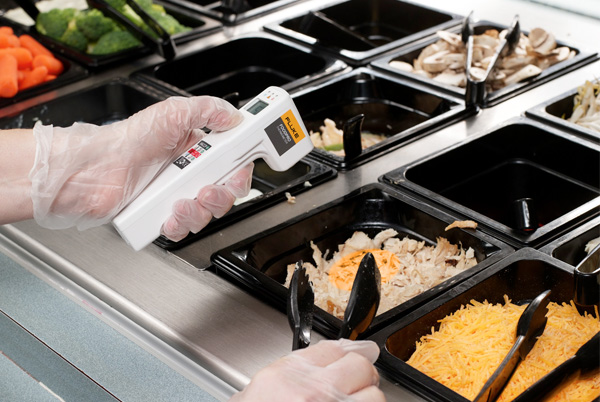Infrared food thermometers are a handy kitchen tool, whether you run a busy catering firm, a high-end restaurant or simply need a food thermometer for your domestic kitchen. With so many choices, however, it’s hard to know which to buy and how to make the most from your choice. Read on for a quick guide to infrared kitchen thermometers and their uses.
Non-contact Infrared Scanners
These are the most common types of infrared thermometers, which are also known as non-contact scanners. Products on the market include the Lazascan 210 Infrared Thermometer and the Irfti550 Infrared Thermometer. Both of these work by using a laser beam to read the temperatures of the food and display it on the LED screen straight away. These types of thermometers can read temperatures across a range from -60 degrees to 550 degrees Celsius.
The benefit of a laser beam infrared thermometer is that the reading is instant and more precise than many other types of food thermometers. A good infrared thermometer will have an easy grip handle and will be run by batteries.
Uses of Infrared Thermometers
Infrared food thermometers are used to measure the temperature of the surface of food. Bacteria most commonly land on the surface of the food which is why it’s important to check that this area is hot enough. Some infrared food thermometers come with an additional probe which can be used to check the temperature at the centre of the food.
Some infrared thermometers can be checked against Comparitor Pots which are used to continuously check the accuracy of thermometers. These are ideal for large kitchens that make regular use of infrared thermometers.
Why Check the Temperature?
High food temperatures can kill many bacteria which are dangerous to anyone who consumes them. These include salmonella, listeria, E coli and botulism. At best, these can cause feelings of nausea and at worst, they can be fatal. Protecting your customers is the number one priority for those in the hospitality trade and the best proven way of reducing the chances of such outbreaks is by ensuring food is served at the correct temperature.
Other Steps to Preventing Bacteria Growth
Checking the surface temperature of the food you serve isn’t the only way to prevent bacteria growth. Keeping your kitchen surfaces clean, storing food correctly and letting certain meats such as pork and steak rest after they’ve cooked will all help reduce the chances of food poisoning occurring in your establishment.
Infrared thermometers are an excellent tool that can be used in conjunction with a probe to offer the best solution for checking both food surface temperature and the temperature in the middle. The options vary in price and also in the distance that they can be held from the food, but all offer precision readings and are easy to use. Having a selection of food temperature gauges in your restaurant will hugely reduce the chances of a food poisoning outbreak, especially when used correctly and checked constantly against a Comparitor Pot.


